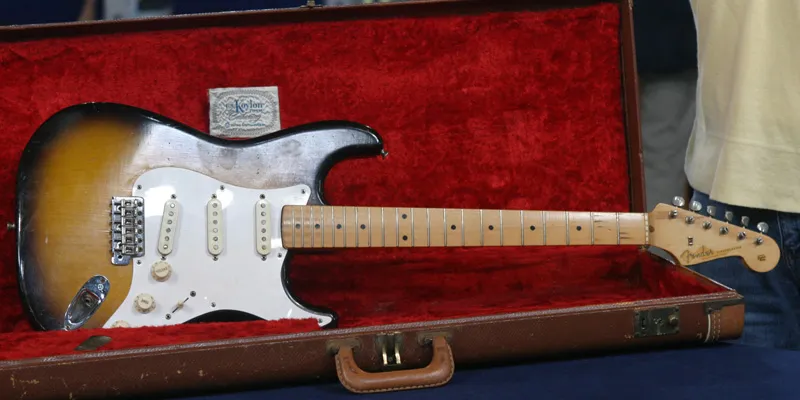Taking Apart Your Guitar? Read This First!
Calling all guitar owners! If you're trying to remove the neck of your guitar, it may not be as simple as it seems. Learn why this DIY project can lead to costly consequences.

Jun 17, 2019
Back in 2004 during ROADSHOW’S visit to St. Paul, Minnesota, a guest named Suzanne brought in a 1957 Fender Stratocaster guitar that was given to her by her late father, an avid music fan. In order to fully inspect the guitar and ensure its date and authenticity, Musical Instruments appraiser James N. Baggett said he had to “take the neck off,” a process which refers to the removal of the fingerboard or fret board that comes out of the guitar's base.
A similar deconstruction also occurred during ROADSHOW’s 2005 visit to Bismarck, North Dakota, when Musical Instruments appraiser Kerry Keane appraised a 1959 Fender guitar. Prior to removing the guitar’s neck, Keane asked permission from the guest, JoAnne, to complete the operation, and added this warning:
"My advice would be, 'Don't try this at home.’ The angle at which the neck is joined to the body is critical in maintaining the 'action.' And the action is determined by the string height in relation to the fingerboard. If it's too low or too high, it's unplayable. And a very subtle change in angle can throw it off...the neck should only be removed by an experienced guitar repairman or technician."
While designing the Stratocaster at Fender back in the 1950s, the designers decided to seal the neck down to the guitar base with “four very simple bolts and a neck plate.” The usage of bolts not only ensured easy removal of the neck when necessary but allowed for easy repairs as well. The best way to ensure you won’t break one of the bolts? According to Baggett: Be the first person to remove them, as they can wear down over time with repetitive tampering.
So why did both Baggett and Keane need to remove the neck of the guitar in order to date it? According to Keane, dating a Fender Stratocaster may require a difficult first step, but then it's a matter of what’s written on the neck: “But the true way to really date the guitar would be to pull the neck out and to read what might be either penciled or stamped here at the end of the fingerboard,” he said. “It's my feeling that the guitar is probably a 1959, and to confirm it, we'd want to pull the neck out.”
Having the date penciled versus stamped can tell you a lot about when the guitar was made. As Keane puts it: "It's a well-known fact that [in 1959] they dispensed with penciling in the dates. They went to a rubber stamp in 1960. Why? Well, there was a rumor that there was a guy at the end of the production line and he was penciling in not the dates but profanity, and then bolting the necks together. Leo Fender heard about it, and said, 'Okay, you guys, no more writing the dates in pencils.'"
Yet when Keane removed the neck, there was no number at all. He explained the reason why to JoAnne: “Looking at this guitar closely, at the pickups, at the quality of the varnish, without a neck date, I still think we're looking at 1959. How do we know this? Inside on the production line, right where the label is, there is a production order number. It is IE, and 'I' standing for the date, 1959, and 'E' for the month of May. So, we can date it exactly.”
Keane estimated that the guitar, with the accompanying amp that JoAnne brought in, could sell for $25,000 at auction.
Back in St. Paul, upon removing the neck, James Baggett was able to determine that the guitar was made in August 1957 after seeing "8/27" marked on it, and estimated the guitar's value to be between $15,000 to $17,000.
Baggett noted another defining characteristic that made Suzanne’s guitar unique and placed its date to 1957 – its sunburst finish. During the development of the Stratocaster, Fender sales chief Don Randall insisted on adding a two-tone color pattern, a “brownish-black outer hue called dark Salem, which graduated to a golden inner hue called canary yellow,” to give the guitar a more high-end look. Baggett also categorized the guitar as having a maple neck and fingerboard, characteristics that were only produced until 1958.
ROADSHOW audiences know that our experts conduct their appraisals with attention to detail and care, never making a drastic choice unless it's necessary to authenticate an item. But Baggett recently told us why guitars are perfectly safe in the hands of ROADSHOW experts :
“If [the neck] is taken off properly, there should never be evidence that it has been removed — but there is a chance. If you follow a professional craftsman’s way of taking it apart, there should be no evidence. It’s ultimately a judgment call — the less you do it, the fewer times you take it apart, the better.”
Nowadays, Baggett said he would probably rely on other characteristics of a guitar to properly date it, only removing the neck if he was purchasing a guitar himself and something didn’t seem quite right.
Still want to remove the neck of your guitar? Ask an expert first.
Related
To learn more about Fender Stratocaster guitars and ANTIQUES ROADSHOW's history appraising them, visit:
The History of the Fender Stratocaster: The 1950s
Read the story of how Leo Fender created the Stratocaster guitar.Breaking Down Your Fender (Don't Try This at Home)
Read more of what appraiser Kerry Keane had to say about this 1959 guitar.Serial number identification and decoding
A timeline of Fender neck dates from 1950 to today.





